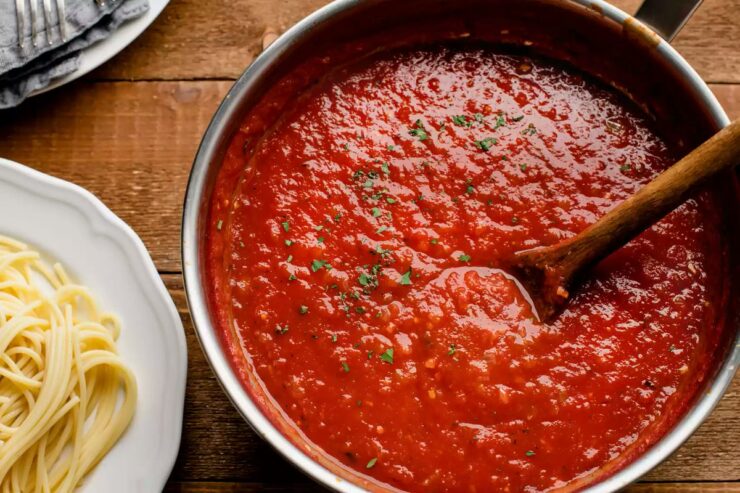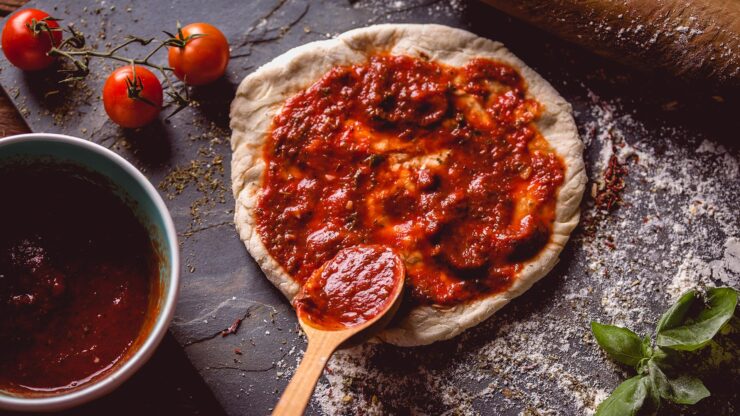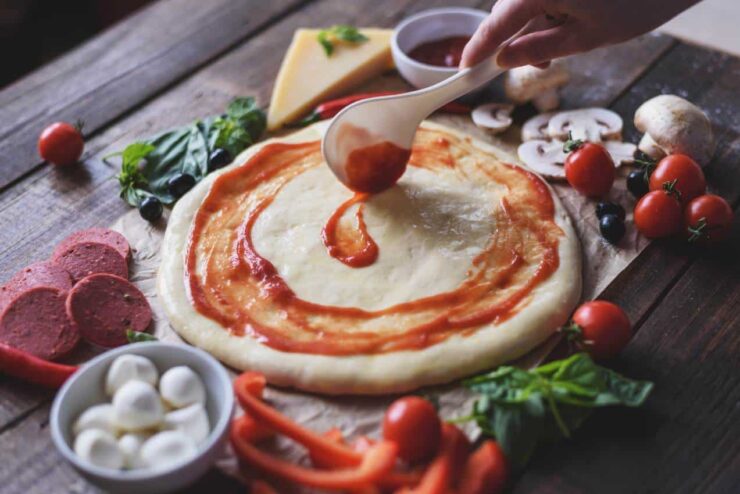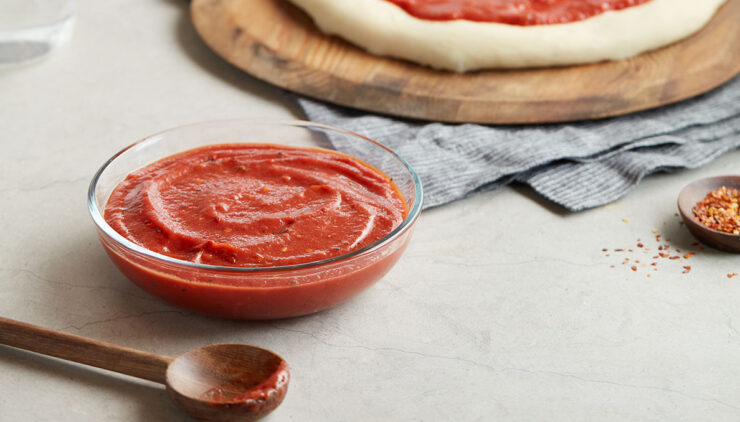It’s challenging to keep track of the distinctions among many tomato-based spices, particularly if they’re all from the same cuisine. When it comes to condiments, Italy is well-known for being a leader in the culinary world.
So we were perplexed the first time we heard about pizza sauce, particularly marinara sauce – weren’t they the same thing? They aren’t!
But how can you distinguish between marinara vs pizza sauce? Pizza sauce is a silky tomato sauce prepared from raw components blended. It doesn’t get cooked until it’s put on the pizza. Marinara sauce is made with additional ingredients than tomato sauce and is simmered before being used in another recipe.
If you’re having trouble keeping up, don’t worry; today, we’ll go through the distinctions between pizza sauce and marinara sauce in great detail.
Difference Between Marinara & Pizza Sauce
What Is Marinara Sauce?

The essential component of Marinara sauce, commonly known as red sauce, is tomatoes. A marinara recipe may contain oregano, garlic cloves, fresh basil leaves, olive oil, bay leaves, red pepper flakes, and tomato paste and can vary from home cook to home chef.
You may use the marinara sauce as a pasta sauce or create spaghetti sauce by adding ground beef or meatballs. Marinara sauce is highly versatile since it may be used as a breadstick dipping sauce.
Ingredients
- Because the tomato sauce provides the majority of the taste, a marinara sauce is effortless to make and requires much fewer components.
- The foundation is made up of tomato sauce, which is the primary component. Please don’t mix tomato sauce with ketchup; they have pretty distinct flavours and are prepared and utilized separately.
- Fresh basil leaves, onion, and garlic; loads and plenty of garlic are other essential components. In comparison to pizza sauce, this implies the sauce is considerably more flavorful.
- The onion and basil are both classic Italian tastes, and a marinara would be incomplete without them; otherwise, it would be a different sauce. To add additional texture to their spaghetti, some people add fresh chopped tomatoes.
- Although salt and pepper should always be added, certain tomato sauces may already be salty enough, and you don’t want to oversalt your lovely sauce.
- Add a dash of balsamic vinegar to your sauce if you want it to have a deeper tanginess.
What Is Pizza Sauce?

Pizza sauce is any kind of sauce that goes on top of a pizza, although it’s usually a tomato sauce with a thin consistency. Pizza sauce, like marinara, has a Neapolitan provenance. For example, Margherita pizza, made with tomato sauce, fresh basil leaves, and mozzarella, was created in Naples.
A pizza sauce is a sauce that goes on pizza, as you may have guessed from the clever name.
We now know that there are many other types of pizza sauce, but the first one utilized was tomato-based. Many people mistake today’s tomato sauce with a simple tomato sauce for pizzas, which is why the term “pizza sauce” was coined to differentiate the two.
A store-bought tomato sauce nowadays has a highly processed, watered-down consistency. It’s typically flavoured with artificial flavours and preservatives and tinted with food colouring.
However, fresh tomatoes are combined to make a good pizza sauce (a classic tomato sauce). Seasonings such as salt and pepper may be added, but no preservatives or chemicals are used. A tomato-based pasta sauce is quite similar to this kind of tomato sauce.
Every cuisine, and even every culture, has its unique variation. However, because pizza is an Italian meal, it’s essential to stick to their definitions of “pizza sauce,” as well as their recipes and techniques, to obtain the best and most natural results.
Ingredients
- Pizza sauce has evolved and changed again throughout the centuries and decades, and we believe it has finally been perfected today.
- The most basic pizza sauces are simple to prepare, with the ingredients used is an essential factor.
- Tomatoes are the foundation of any pizza sauce. Of course, we prefer fresh tomatoes, but if you’re not up for the effort, canned tomatoes or even canned tomato sauces have a similar fresh flavour and can suffice in a pinch.
- Use half whole peeled tomatoes and the other half smashed when using canned tomatoes. If you’re using fresh tomatoes, you’ll need to prepare them first before you can make the sauce (we will discuss this in the next section).
- Sugar (granulated white or brown sugar) is essential for cutting through the acidity and rawness of the tomatoes. The sauce will be dull and unappealing without it.
- Next, the fundamental seasoning components, such as salt, black pepper, and Italian seasoning, are discussed.
- In every dish, particularly savoury ones, salt is a must-have component. It should be freshly ground to get the most flavour from the black pepper, and Italian seasoning is a must-have.
- The dried herbs basil, oregano, rosemary, and thyme make up Italian spice. You may also make your own, adding some dried garlic flakes if desired.
- This leads us to the next component, garlic. Garlic flakes are an alternative, but freshly minced garlic is a superior choice, as we just stated. Garlic is a spicy fragrance that is used extensively in Italian cooking.
- Now we’ll move on to the components that aren’t necessary but are highly suggested. Again, only onion, fennel seeds, parmesan, and olive oil are used.
- Finely chopped shallots or onions serve as an aromatic in the same manner that garlic does. It adds texture and a semi-sweet savoury taste, and it truly makes a difference.
- The use of parmesan cheese, mainly if used as a topping, is entirely optional.
- The olive oil is mainly used to thin the mixture if it becomes too thick. It also has a more pungent taste than other oils such as sunflower or canola.
Buying guide for Marinara and Pizza Sauce

Aroma
When you are checking the aroma of the pizza sauce, you need to sense whether it has a rich tomato flavour or not. You must choose the right kind of flavour for yourself so that your taste buds get satisfied with every bite you take.
Sweetness
The sweetness of the pizza sauce can be checked by dipping your index finger in the sauce and tasting it. A good sauce must not be too sweet or sour but mild in taste.
Thickness
Pizza sauce comes in different thicknesses, from thin to thick. It all depends on your preference which you choose while buying the pizza sauce.
For some people, a light coating of the pizza sauce may not be enough, and they might need to add more than one can of the sauce to make it thick.
FAQs

What is the difference between Marinara Sauce and Pizza Sauce?
Marinara Sauce is a red sauce that includes tomatoes, garlic and onions. Pizza Sauce is typically made with the same ingredients but can also include herbs like basil and oregano.
Why are these two sauces so different even though they have similar ingredients?
Pizza sauce has additional herbs added to it, such as basil and oregano. The marinara sauce does not have these additional herbs.
Should I eat one or the other on my next pizza night?
These sauces are both commonly used on pizza. However, marinara is typically paired with toppings such as mushrooms and peppers, while pizza sauce is paired with items such as meatballs and pepperoni. Obviously, it depends on your preference whether you should eat one or the other next time!
Conclusion
Tomato sauce is used to make marinara sauce, as we’ve covered throughout this article. Pizza sauce is a kind of tomato sauce; therefore, it cannot be substituted for marinara. Marinara vs pizza sauce may, however, be used as a marinara sauce foundation.
Take a look at the following list:
